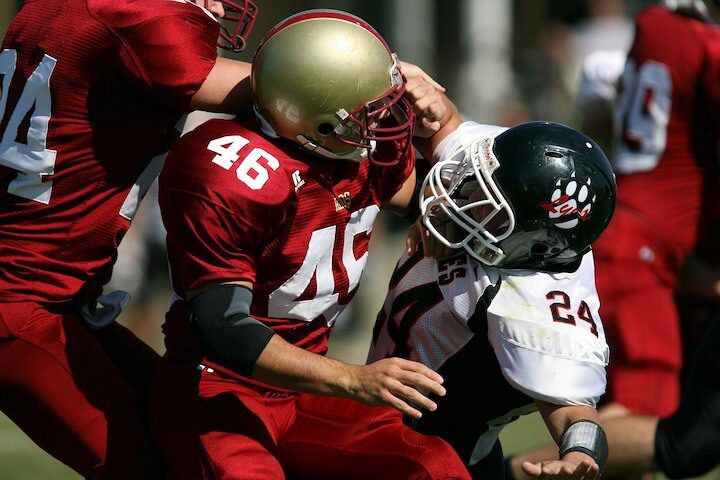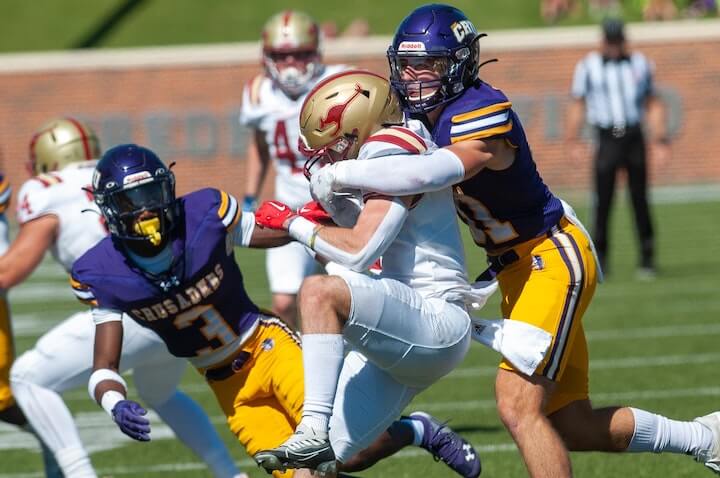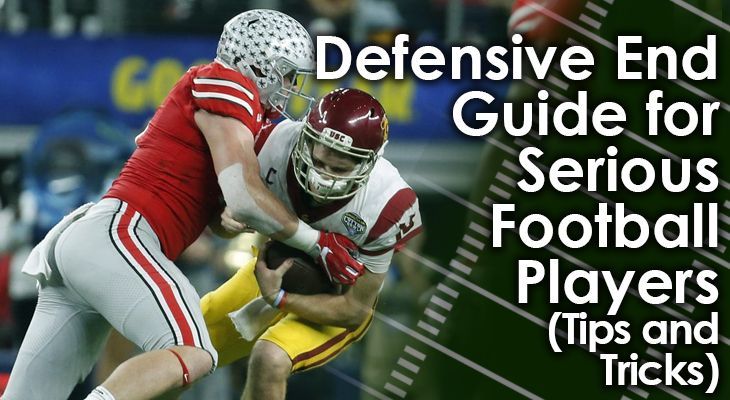Defensive ends are some of the most athletically gifted players on a football field.
Many people would say that quarterbacks, running backs, and other "skill position" players on offense would take that title.
But defensive ends have a rare combination of size and speed, to go along with excellent vision, great pursuit, and relentless will to make plays.
A great defensive end can completely change the outlook of a defense, and disrupt a game all on his own.
But, what does it take to make a great DE?
And what are the necessary skills and traits needed?
Let's take a look:
What is a Defensive End in Football?
Defensive ends are strong and physical players.
The defensive end is primarily responsible for defending against the opposing team's running plays and putting pressure on the quarterback during passing plays.
They play out of the defensive line, making it necessary for them to have enough strength to take on big offensive linemen and tight ends.
In fact, defensive ends matchup against offensive tackles — typically the largest players on the offensive line — on almost every play.
Despite this, one of the main jobs of a DE is to put pressure on the backfield — disrupting the quarterback, hunting for sacks, and chasing down ball carriers.
Their mix of speed and strength will come in handy as they evade offensive tackles and rush the backfield to take down shifty running backs.
Defensive End Position on the Field
Defensive ends are defensive linemen who typically matchup against offensive tackles.
As their name suggests, they line up at the line of scrimmage but start each play from both ends of the defensive line.
Playing out of this position, one of their top priorities is blowing by the offensive tackles to put pressure on the backfield — either to contain the outside run, disrupt the quarterback’s play, or record a sack.

What Does a Defensive End Do?
As touched on earlier, defensive ends play a unique role on the defensive line.
Instead of trying to overpower their offensive counterparts, they need to rely on their ability to evade blocks and get to the back field as fast as possible.
This gives DEs a unique set of roles and responsibilities as part of the defensive line.
Here are a few of them:
1. He Must Keep Outside Contain
Outside contain means that a DE can't let any runner get to the outside of him.
While defensive ends don’t need to tackle every ball carrier coming his way, he needs to at least force them back inside where most of his fellow defenders are.
To do this, he has to make sure that he positions his body between the ball carrier and the sideline. He does this by shifting laterally to the outside, forcing the ball carrier to go back inside.
Of course, DEs can attack ball carriers and make tackles on their own…
But overcommitting to this might open up the defense, allowing runners to get outside of them.
2. He Must Put Pressure in the Backfield
One of the primary responsibilities for a defensive end is to put pressure in the backfield.
This goes for both running and passing plays.
By getting into the backfield and disrupting the line of scrimmage, DEs can free up other defenders to make big tackles.
On running plays, this task goes to linebackers most of the time. If DEs are able to gobble up OTs and maybe even guards, then there's plenty of space for linebackers to attack.
On passing plays, DEs need to be as disruptive as possible. They need to put pressure on quarterbacks to make them throw the ball away or throw the ball sooner than they would've liked.
In the best-case scenario, DEs will rack up a lot of QB sacks and knock-downs.
3. He Must be a Complementary Player
While a defensive end can often stand out as the star on a defense, it's a position that also must be very complementary to other players.
He'll do this by keeping outside contain, for example.
Another way is by putting pressure in the backfield, opening up space for other defenders.
Ultimately, a DE can be a complementary player by quickly recognizing the play and reacting appropriately.
By not over-committing to a pass or run, to a sack or tackle, DEs will always stay in control.
That is really the key word for defensive ends -- control.
It can be easy for a DE to get out of control when they're rushing the quarterback. If they see a sack, they go for it.
But if they over-commit, they could easily be fooled by a draw play, with the running back getting outside of them for a big gain.
5 Successful Defensive End Traits
Here are a few traits defensive ends need to be effective in their position:
1. Defensive Ends are Athletic
Defensive ends need to be very athletic.
They will need to be athletic enough to elude burly offensive tackles and pursue quick, shifty running backs and quarterbacks.
Remember that DEs will match up against offensive tackles on almost every play.
These OTs are typically the largest offensive linemen, meaning the DEs will have quite the challenge taking them on -- or, better yet, avoiding them altogether.
They'll need quick feet to do this, as well as the ability to make moves and use their hands to break free from blockers.
DEs are also responsible for tracking down running backs who are trying to run to the outside. This will take the ability to shift courses and make quick lateral moves.
And finally, they'll need to pursue and put pressure on quarterbacks on passing plays.
2. Defensive Ends are Perfectionists
Unlike defensive tackles, defensive ends can't just use their size and strength to bull rush straight forward.
They'll be facing a size and strength mismatch with OTs on every play.
The way they can beat the OTs is not just with their speed, but with great technique.
Mastering these moves takes a lot of practice, of course, but it also takes a lot of studying.
Great DEs constantly perfect their craft, learn from others, and plan particular moves against specific OTs.
They learn this by watching lots of film and then putting what they see into practice
3. Defensive Ends are Agile
Just about every position in football requires a player to have quick feet
But, this is EXTREMELY important for DEs.
The only way defensive ends can be really successful is if they get a really quick burst right at the snap of the ball.
The first step for a DE is very important, as it can give them the upper hand on OTs right from the start.
Beyond getting off the ball quick, DEs have to be shifty too.
Much like running backs, DEs have to constantly analyze what's happening in front of them.
They'll need to adjust their body positioning and running direction to compensate for what the offense throws at them.
DEs need exceptional agility to be great at rushing quarterbacks, clogging up running lanes, and making open-field tackles.
4. Defensive Ends are Flexible
Defensive ends are the "free roamers" of a defense.
Just about every other position will have more straightforward techniques for them to succeed.
While DEs will have more freedom to use different moves and go in different directions to get the job done.
Because of how they'll need to move their bodies, it's very important for DEs to be flexible.
They'll need to bend their bodies in somewhat awkward ways, while taking on blocks from OTs.
They'll also need to be able to duck down under blocks, or shift to the left and right to get around blocks.
This all will take quite a lot of flexibility.
Being flexible will allow DEs not only to accomplish what they need on every play, but also avoid injuries.
5. Defensive Ends Have Great Vision
What a defensive end does on a particular play depends on what's happening in front of him.
In order for him to do this well, he needs to have great vision.
Unlike defensive tackles, defensive ends have to look into the backfield to see what's going on.
Then, they'll then need to adjust how they're attacking based on what's happening:
On passing plays, DEs can simply attack the quarterback straight on.
But on running plays, DEs need to be a little more careful.
They have to keep outside contain, which forces them to get more depth and width on their attack.
When the offense goes with an inside run, they need to press down the line of scrimmage to tighten the box.
The only way a DE can do this successfully is to have great vision.
He needs to be able to recognize what's going on while attacking at the same time.
Defensive ends don't have the luxury of being able to stand back and view the field, as linebackers or safeties do.
Best Defensive Ends of All Time
There have been many great defensive ends who possessed all the traits, especially at the peak of their careers.
Here my take on the top 10 Defensive Ends of all time (so far):
1. Reggie White
2. Deacon Jones
3. Bruce Smith
4. J.J. Watt
5. Doug Atkins
6. Joe Greene
7. Gino Marchetti
8. Julius Peppers
9. Howie Long
10. Michael Strahan
3 Defensive End Tips
1. Work on Footwork
As mentioned before, it's very important for DEs to have great footwork.
They need to have agility, be quick, and be able to shift back and forth.
A great way to do that is to work on agility drills.
Anything that involves chopping feet, shifting body weight, and sprinting forward, backward, and sideways is a good idea.
Defensive ends need to build up this agility and continually work on it in practice every day.
2. Improve Your Hands
A DE has to have strong hands, too.
They are constantly fighting away blocks by big, bulking OTs.
They also need to get their hands up to deflect passes, and make tackles when needed.
To do all this, DEs need to have strong hands.
Weight lifting will help with this somewhat, but they should also work on handwork in practice.
Some defensive line drills include the Karate Drill and Wall Ball, where they can work on hand-eye coordination.
3. Study the Game
DEs need to understand the game and how certain players on offense react on certain plays.
The best way to do that is to simply watch a lot of football.
It's simple for DEs to watch some great players at their position on TV.
There are loads of skilled DEs at the college and professional level who play every weekend.
In addition, DEs can study film with their coaches.
This allows them 1-on-1 coaching and breakdowns of plays in slow motion.

Conclusion
Defensive ends are part of the defensive line and are some of the most disruptive players on a defense.
Truly exceptional DEs can change a game around all on their own.
DE is not an easy position to play, though.
It takes a lot of skill, a lot of strength and a lot of smarts too.
If you want to be a great defensive end, start by studying some of the best players and then work hard to replicate what they do.

